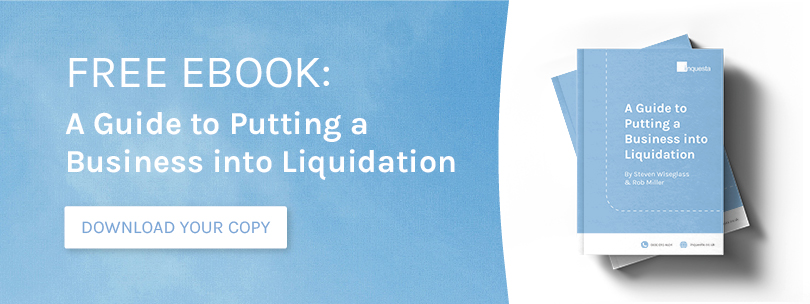If you are looking to start a claim against a company that has or is about to enter the liquidation process, you may think that you will have no chance of success. Thankfully, this is not necessarily the case.
That being said, when deciding whether to bring a claim against a company in liquidation, it is extremely important to establish if it is commercially worthwhile or suitable to do so. When a business enters a formal process, restrictions might be imposed on the ability of creditors or prospective creditors to bring a claim against the business or its directors.
Which Insolvency Procedure was Used?
Whether or not bringing a claim against a company in liquidation is a good idea can depend largely on the method of insolvency that was used.
Administration
Putting a business into administration creates a moratorium that prevents the commencement or continuation of legal proceedings against the firm without the consent of the administrators themselves, or a court order. If a claim has already been started, it will automatically be stayed.
Current insolvency legislation allows for the administrator to adjudicate on claims if they already intend on making a distribution to unsecured creditors. If the administrator accepts the claim, then the claimant will receive an equal return as all other unsecured creditors. If the application is rejected, the claimant can appeal the decision through the insolvency courts.
Winding Up by the Court
After a winding up order has been made, or a provisional liquidator appointed, it will not be possible for any new claims to be made against the company. In addition, all current claims will be halted. This is unless they have been specifically allowed by the court. If a winding up petition has been presented, but a winding up order has not yet started, a creditor can apply to the court to stay, sist or restrain any proceedings.
If permission is requested to bring or continue with any action, a balancing exercise will be carried out to consider the interests of the party wanting to commence or continue proceedings, versus the interests of creditors as a whole. The onus is on those wanting to bring a claim to demonstrate that it is appropriate to do so.
Liquidation
The liquidation process can be started by a firm’s creditors via the courts (compulsory), or by the company itself via a creditors’ voluntary liquidation (CVL). If the defendant in a claim goes into compulsory liquidation, the process runs exactly the same as the Administration procedure explained above. Should the business go into liquidation voluntarily, there will be no automatic restrictions put in place to prevent any legal action – although the liquidator is able to apply for one.
If you are thinking about bringing a claim against a company in liquidation, it is extremely worthwhile to consider whether it is best to take legal action, or try to agree the claim with the liquidator themselves. This is because the liquidator has the statutory power to commence or continue proceedings on the company’s behalf.
Should the company enter into a company voluntary arrangement (CVA), the position on whether a claim can be brought against the firm will depend on the terms of the CVA itself. Small businesses that have filed a CVA proposal may be protected by a moratorium, which will prevent any action against the company – whether a claim has already started or not.
Although it may be competent to bring a claim against a company in liquidation, this does not necessarily mean that such action is commercially worthwhile. Even if your actions are successful, payment is not guaranteed and will depend on the financial position of the firm. However, if the business has insurance policies in place, it may be possible to take action against the insurer instead.
Advice on Bringing a Claim Against a Company in Liquidation
If you are thinking of bringing a claim against a company in liquidation, there are a number of points to consider. These include:
- Try to influence the process: Administrators and liquidators have the power to investigate a company and the conduct of its directors. Since these processes are often creditor-driven, it is important to remember that you are able to influence and hold these office-holders to account, or even replace them or nominate your preferred choice.
- Obtain and enforce judgement: It is important to obtain and enforce a judgement against a company that is suspected of having some assets, even if it is unable to pay all of its debts. A freezing order can also be granted in extreme cases, if the debtor is suspected of fraud.
- Submit a proof of debt: This may seem like an obvious thing to do, however it is a good idea to submit a Proof of Debt to a liquidator as administrator to help your case. It is essential that these are completed correctly, however, to ensure your claim is properly registered.

What if the Company has Already Been Dissolved?
If a business has already been through the liquidation process and is now completely shut down, it is no longer possible to bring a claim against them. This is because the firm will have lost its legal identity. If you still would like to go ahead with this, you would first of all need to have the business restored to the Register of Companies.
Seek Expert Advice
Bringing a claim against a company in liquidation can be an extremely complicated process, full of significant risks and hurdles that need to be overcome. It is therefore essential to seek out professional and independent advice at your earliest possible opportunity.
At Inquesta, we are completely dedicated to achieving the best possible results for our clients. This is why we will take the time to thoroughly understand your situation, before using our decades of experience to assess your chances of success – potentially saving you a lot of time and money.
We have lived and breathed the insolvency industry for many years, leaving us perfectly placed to assist with all aspects of the process. This is why we have created a free downloadable guide: “A Guide to Putting a Business into Liquidation”. Covering everything from warning signs to a full breakdown of how to liquidate a firm, this handy eBook is a must for business owners.
For more information about how Inquesta can help you, contact a member of our team today or book a free, no obligation consultation.



